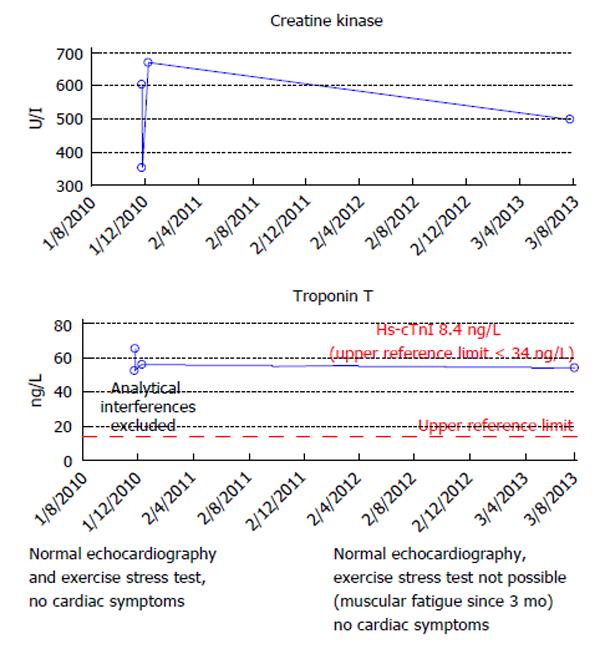Copyright
©2014 Baishideng Publishing Group Co.
World J Cardiol. Apr 26, 2014; 6(4): 175-182
Published online Apr 26, 2014. doi: 10.4330/wjc.v6.i4.175
Published online Apr 26, 2014. doi: 10.4330/wjc.v6.i4.175
Figure 3 Creatine kinase and high-sensitivity cardiac troponin T and I in a 72-year-old male with late onset limb-girdle muscular dystrophy.
This patient presented first to our outpatient clinic in 2010 because of clinically unexplained increased high-sensitivity cardiac troponin T (hs-cTnT) concentrations. The echocardiography, exercise stress test and renal function were completely normal, the patient was free of any cardiac symptoms. In 2010 analytical interferences with the hs-cTnT assay were excluded by serial dilution experiments and an interference by heterophilic antibodies could be ruled out by addition of antibody blocking agents to the sample. There was no evidence for macro creatine kinase as well. As the patient had no cardiac symptoms or symptoms suggesting skeletal muscle disease no further work-up was done. In 2013 the patient developed typically symptoms of muscular dystrophy and was again seen in our outpatient clinic. The electrocardiogram and echocardiogram remained normal, he still had no cardiac symptoms but an exercise stress test was no longer possible because of skeletal muscle fatigue. At this visit we found a marked discrepancy between hs-cTnT (moderately increased) and hs-cTnI (normal) suggesting a release of hs-cTnT from chronically injured skeletal muscle by previously already described reexpression of cardiac cTnT isoforms. In retrospect, unexplained hs-cTnT increase in this patient was an early sign of late onset muscular dystrophy.
- Citation: Mair J. High-sensitivity cardiac troponins in everyday clinical practice. World J Cardiol 2014; 6(4): 175-182
- URL: https://www.wjgnet.com/1949-8462/full/v6/i4/175.htm
- DOI: https://dx.doi.org/10.4330/wjc.v6.i4.175









